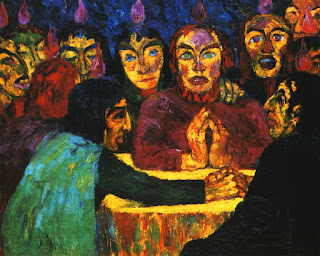Artist: Mary Wilshire
Medium: Four Color Process comic book cover
Size: 17 x 26 cm
Date: 1993
Location: From “The Life of Christ: The Christmas Story” New York: Marvel/Nelson.
Luke 2:4-7 So Joseph also went up from Galilee, from the town of Nazareth, to Judea, to the city of David which is called Bethlehem, because he was of the house and family line of David, to be registered together with Mary, who was legally promised in marriage to him and was pregnant. And it happened that while they were there, the time came for her to give birth. And she gave birth to her firstborn son, and wrapped him swaddling cloths and laid him in a manger, because there was no place for them in the inn.
The birth of the baby is described simply. “swaddling cloths” were strips of cloth used to wrap a baby. That the Child was put in a manger may mean that the birth was in a stable. There is a tradition that Jesus was born in a cave, which could have been used as a stable. Mangers were often outdoors, so it is possible that Jesus was born in the open air. If ever there was an opportunity for God to enact his plan with a majestic flourish, it was at Jesus' birth. But God did not presume upon humanity when he stepped in to redeem it. There was no pretense in this arrival. Rather, God chose to identify in the humblest way with those made in his image.
This adaptation of the nativity story for the comic book medium was by writer Louise Simonson and American penciller Mary Wilshire (b. 1953). At a young age Mary was influenced by newspaper comics and Mad magazine artists such as Jack Davis, Stan Drake and Alex Kotzky. She began her career in underground comix, and got her first work at Marvel Comics around 1980 working on Crazy. She is most well known for her work in the early 80s as the penciller and cover artist on Marvel's Red Sonja. This is another example in the decades long history of comic books used to spread the gospel, from Classics Illustrated to Japanese manga!












.jpg)










_Christus_ein_krankes_Kind_heilend.jpg)








